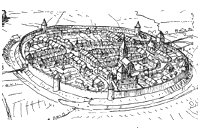Keine |
Development as a trading city
.jpg.aspx) The significance of Sankt Vith as a trading city grew in the 13th century.
The significance of Sankt Vith as a trading city grew in the 13th century.
The Sankt Vitus bushel (Vitus bushel) is mentioned in the deeds of purchase from this period and these bushels were even valid until the French lordship.
Johan of Valkenburg-Montjoie, a Luxembourgian vassal, made history as Lord of Sankt Vith; under his lordship the meaning of Sankt Vith as a trading city was strengthened. As such the building of the castle and the city walls with their fortified towers, took place in 1350.
Sankt Vith was also renamed a city in this period and was allowed since then to carry the weapon (Luxembourgian-Valkenburg lion) that until this day still refers to the first well-known Lord of Sankt Vith, Johan of Valkenburg. Moreover, the last heir of this house had ordered to mint coins in Sankt Vith: the ‘moneta Sancti Viti’.
After the death of Johan (1352) the Valkenburg inheritance battle started between his sister and the faithful Valkenburg people. Only in 1380 the Knights Court of the Duchy of Luxembourg, allocated the county of Sankt Vith to Simon of Sponheim-Vianden and appointed Duke Wenzel of Luxembourg as suzerain of the area.
Simon of Sponheim was married with the daughter of a count, Maria of Vianden. The area around Sankt Vith expanded now to a unit that belonged to the County of Vianden and existed in this format for 400 years.
After the death of the last heir of Sponheim in the year 1417 the County Vianden, with its lordship of Sankt Vith, came into the possession of the Count of Nassau (who later was called the Prince of Oranje-Nassau). The Lords of Nassau, and more specifically of Oranje-Nassau, who only lived part-time in the Castle of Vianden, let prefects (for example van Rolshausen, van Münchausen, Kröff, Baring, de la Fontaine, van Dhaeme) rule over the lordship of Sankt Vith in their name.
The prefects lived in the Castle of Sankt Vith. Yet as the highest landlords, the counts and later the dukes of Luxembourg were more favourable of our area.
Since Sankt Vith was connected to Vianden, the meaning of the city under the lordship of the count of Sponheim and the duke of Nassau grew; the city expanded economically (trading city), administrative (the Supreme Court was the seat of the tenants and the prefects) and military (accommodated a garrison) to a centre, as strategically important point at the northern border of het County. The economic rebirth, however, was interrupted in the course of the centuries by wars, fires and epidemics.
Thus, the Black Plague, that raged in the middle of the 14th century through Europe, also killed a large part of the inhabitants of Sankt Vith. In this period (around 1350) we can probably find the building of the first hospital. City fires destroyed the city several times in the 16th century, which can be seen in the year 1517 and before 1541.